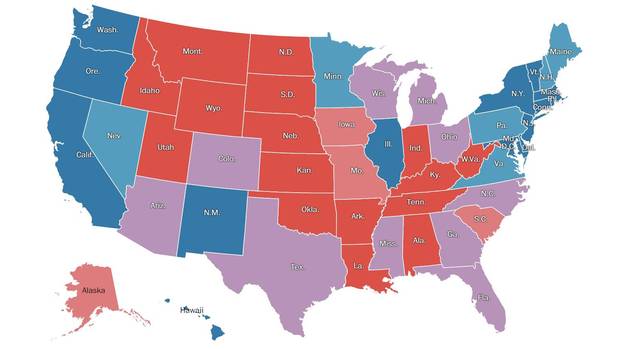
The Washington Post and Survey Monkey polled 74,000 registered U.S. voters. Blue states signal Democratic strongholds, Red are Republican and Purple states could be won by either party.
Graphic: The Washington Post/Survey Monkey
A new poll suggests that, beneath the tumult, this presidential election could signal a realignment of states within the Republican and Democratic coalitions, with the GOP increasingly popular in the troubled industrial Midwest, and the Democrats coming on strong in the South.
The Washington Post and Survey Monkey released a poll Tuesday that individually examined all 50 states. On the whole, the news is good for Hillary Clinton's Democrats, who lead by at least four points in 20 states representing 244 electoral college votes, just shy of the 270 needed to win the presidency.
Donald Trump's Republicans are also advantaged in 20 states, but those states are on the whole much smaller, providing only 126 electoral college votes. That means Mr. Trump will need to secure almost all of the 10 toss-up states to win.
But what really fascinates is where the Democrats and Republicans are each showing surprising strength. Although Pennsylvania and Michigan have both voted Democrat for six straight presidential elections, Republicans are within four points of the Democrats in the former and within two in the latter.
And the GOP is within two points of the
Dems in Wisconsin, which last hasn't supported a Republican candidate since the Ronald Reagan landslide of 1984.
New @washingtonpost/@SurveyMonkey poll of all 50 states details Clinton advantage over Trump https://t.co/BGiVO6x7Wh pic.twitter.com/EDjK8IJlUH
— Mark Blumenthal (@MysteryPollster) September 6, 2016
Mr. Trump is clearly making inroads in states where traditional manufacturing industries are in decline, leaving large numbers of white, semi-skilled labourers underemployed and resentful. Those voters looked to Democrats to protect their interests in the past. Could they become part of a new Republican coalition?
Conversely, Hillary Clinton leads Mr. Trump by a single point in Texas–Texas!–which hasn't voted for a Democratic president since Jimmy Carter in 1976.
She also leads by a point in Arizona (Republican since 1952, with the single exception of 1996) and is tied with Mr. Trump in Georgia, which last went Democrat in 1992.
The Democrats are even competitive–two points behind–in Mississippi, a Republican stronghold since 1980.
Redrawing the electoral map. Research with the @washingtonpost https://t.co/q7VWAyFel8 #Election2016 pic.twitter.com/tdtkn02SQh
— SurveyMonkey (@SurveyMonkey) September 6, 2016
The antipathy of African-American and Hispanic voters towards Republicans in general and Mr. Trump in particular, and the growing disillusionment of white working-class voters with the Democrats, could be redrawing the electoral map.
So which party would benefit more? The Midwest is full of big swing states that the Republicans would love to put in their pocket.
But Texas has 38 electoral college votes, and is growing fast. If the Lone Star State ever becomes reliably Blue, then it will be a cold day before a Republican candidate wins the White House.